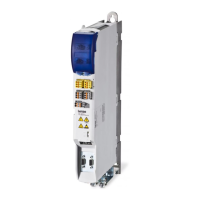Configuration
Basic configurations
8.2.4 Speed synchronism
8-23
L
EDSVS9332S-D11 EN 3.0
8.2.4 Speed synchronism
8.2.4.1 How to select the correct configuration
The following
slave configurations can be selected for the speed synchronism with the master
configuration C0005 = 5XXX:
z Slave for setpoint bus C0005 = 6XXX;
for only two drives or fixed speed relationships which must be set only once (commissioning)
z Slave for setpoint cascade C0005 = 7XXX;
for more than two drives or simple change of the speed relationship with stretching factors in
the running process
A correction value for the speed synchronism can be changed and displayed via the input
DFSET-N-TRIM in the DFSET function block.
The input can be changed by reconfiguration via:
z analog terminal
z motor potentiometer
z keypad
z automation interface or system bus
The correction value is provided in % of C0011 (n
max
).
Deactivate the phase controller for the speed synchronism. This means that the phase-synchronous
running becomes a speed-synchronous running, which results in adding phase errors between the
drives. The phase controller can be deactivated by setting code C0254 to zero.
8.2.4.2 Speed-synchronous running
Purpose
For material transports with very low stretching coefficients, such as paper, metal, etc., the tension
can be set via the gearbox factor C0032/C0033 by oversynchonism in the ‰ range. A specified
tension thus results from the stretching coefficient of the material. For a better operation and higher
accuracy in the digital frequency coupling, we recommend the digital frequency cascade C0005 =
7XXX.
8.2.4.3 Speed ratio synchronism
Purpose
z Stretching systems
z Wire-drawing plants
Example
Extruder system with stretching of plastic threads by a speed ratio synchronism. The stretching is
performed online during the process via a motor potentiometer function.

